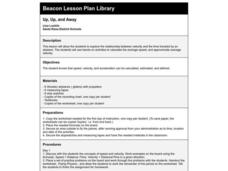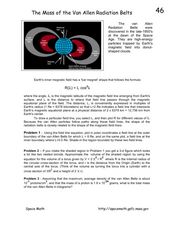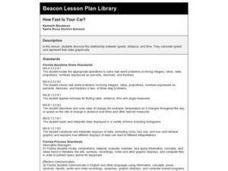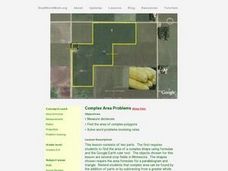Curated OER
Spotting an Approaching Asteroid or Comet
In this asteroid and comet worksheet, students read about the formula used to determine the brightness of asteroid. They apply this formula to solve 2 problems about asteroids and their brightness.
Curated OER
Speed and Experiments
In this speed and experiments activity, students read about how to calculate the speed by using the change in distance divided by the change in time. They also read about experimental design and scientific method. Students match 5 terms...
Curated OER
The Webb Space Telescope: Detecting Dwarf Planets
In this detecting dwarf planets activity, students read about the Webb Space Telescope that will be launched in 2014 to detect dwarf planets using an infrared telescope. Students solve 3 problems and create a graph for each using given...
Curated OER
Up, Up, and Away
Students study the concepts of speed and velocity and complete practice problems. In small groups, students fly airplanes and record time and distance traveled for each flight. They calculate the speed and velocity of their plane for...
Curated OER
Black Holes...III
In this black holes worksheet, students use a formula for time dilation which causes delays in events that occur near the black hole. They solve 6 problems using the equation.
Curated OER
The Mass of the Van Allen Radiation Belts
In this van Allen Radiation Belts worksheet, students are given the formula for the field line of the Earth's inner magnetic field. Students use this equation to find the polar coordinates of a field line in the van Allen Belts. They...
Curated OER
Geometry of Triangles Using a Protractor
Seventh graders use a protractor to measure angles and solve a problem involving distance. In this measuring angles with a protractor lesson plan, 7th graders calculate the distance of a line on a diagram by using a protractor to measure...
Curated OER
Measurement and Data Collecting using Image Processing
Students trace the route of the historical event and measure the distance over which the people involved journeyed. A data sheet be constructed outlining the location of events, and the speed with which the journey occurred.
Curated OER
The Rocket Sled
In this secondary mathematics worksheet, students use the given information regarding a rocket’s distance and time to calculate the speed of sound. The one page worksheet contains one problem with the solution.
Curated OER
To the Moon
Pupils explore circumference manipulating Moon Pie wrapper. In this geometry lesson, they manipulate snack wrappers to find circumference, diameter, radius and distance.
Curated OER
How Fast Is Your Car?
Eighth graders discover the relationship between speed, distance, and time. They calculate speed and represent their data graphically. They, in groups, design a ramp for their matchbox car. The goal is to see who's ramp produces the...
Curated OER
Geometric Sequences and Series
In this algebra activity, students solve sequences using the geometric mean for sequences and series. They have to find the next number in the pattern using the formula for geometric means. There are 23 problems to be solved.
Curated OER
Speedy Trials
Fifth graders investigate how forces affect the motion of an object. In this physics lesson, 5th graders calculate an object's speed using a mathematical formula. They discuss how force and mass affects the speed.
Curated OER
Chandra Explores Angular Size
In this angular size worksheet, high schoolers read about how astronomers determine the size of objects in the sky by using their angular size. Students are given equations that allow scientists to convert the angular size into...
Curated OER
What is Work?
In this work worksheet, students will match vocabulary words with definitions: joule, Newton, force, and work. Then students will answer 8 problems based on the equation: work = force x distance.
Curated OER
Black Holes....II
In this black hole worksheet, students use the equation for time dilation to solve 8 problems including determining the time it takes to receive a GPS signal from space, the time delay for the GPS-Earth system, the distance a radio...
Curated OER
Can You Hear My Now?: Getting the Message Across
In this power transmittance worksheet, students read about sources that transmit power and are given a chart with the distance and the power transmitted by each device. Students determine the intensity in watts of the power for each...
Curated OER
Introduction to Work
Fifth graders define work, force, and energy and calculate work done using a simple formula. They observe the teacher using an Equi-beam and identify the fulcrum, calculate different work problems, and participate in a class discussion.
Curated OER
Complex Area Problems
Students calculate the area of different polygons. In this geometry instructional activity, students find the area of complex polygons. They solve word problems using rates and distances.
Curated OER
Magnetic Induction
For this electricity worksheet, students learn about magnetic induction plus compare a generator with a motor. Students also review the different kinds of energy and the formulas associated with energy. This worksheet has 28 matching, 10...
Curated OER
Exploring the Ares 1-X Launch-Energy Changes
In this energy changes worksheet, learners solve 5 problems using the formulas for potential and kinetic energy related to baseball energy, coasting rocket energy and the energy of falling stones.
Curated OER
Lunar Meteorite Impact Risks
In this lunar meteorite impact activity, students read about the dangers of meteorite impacts while exploring the moon. Students solve 7 problems including finding the area of the side of the moon that faces the Earth, calculating the...
Curated OER
Wave Math
Students identify the different factors affecting the size and shape of ocean waves. In this math lesson, students calculate wave speed and wavelength given a mathematical formula.
Curated OER
Exploring Transformations: Translations and Reflections
Learners perform translation and reflection. They identify the coordinate points of the new graph and create a formula for the movement. They identify the pre-image the and after image.























